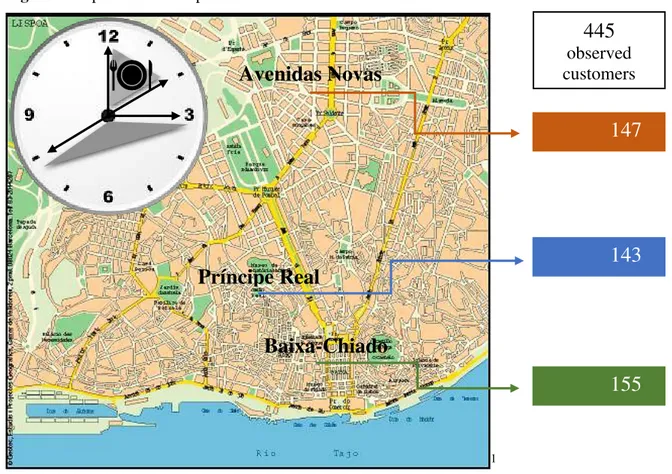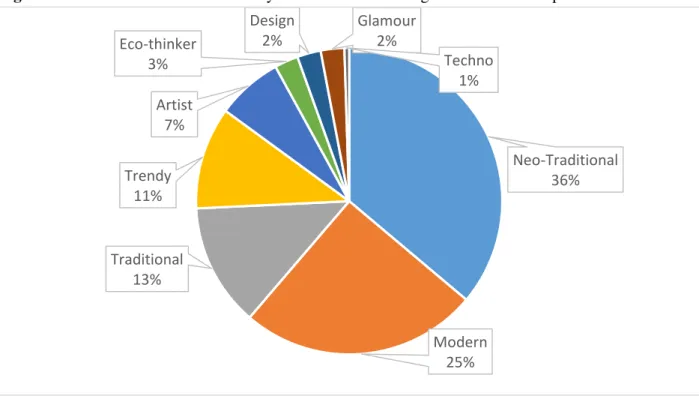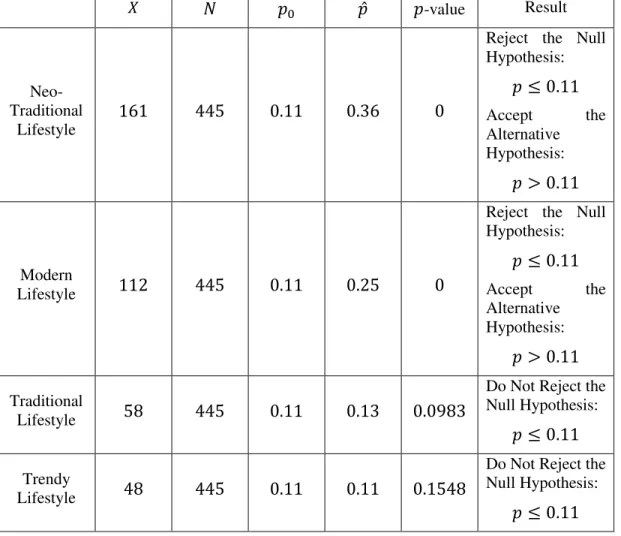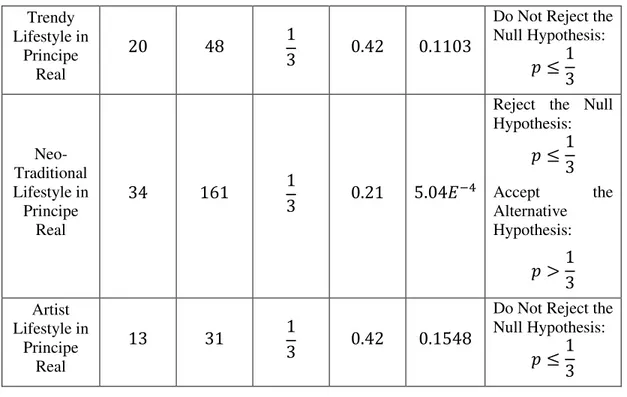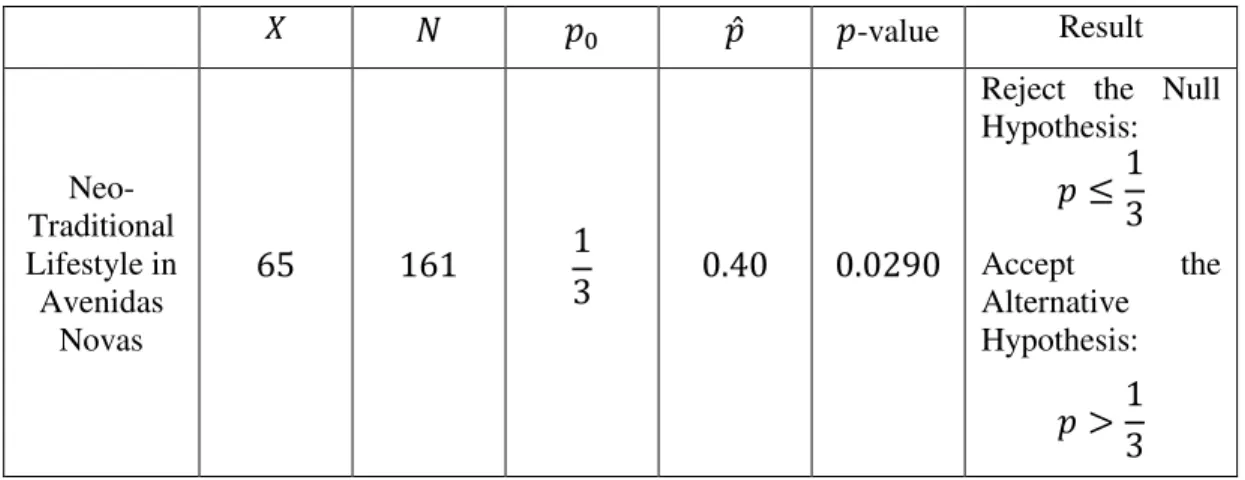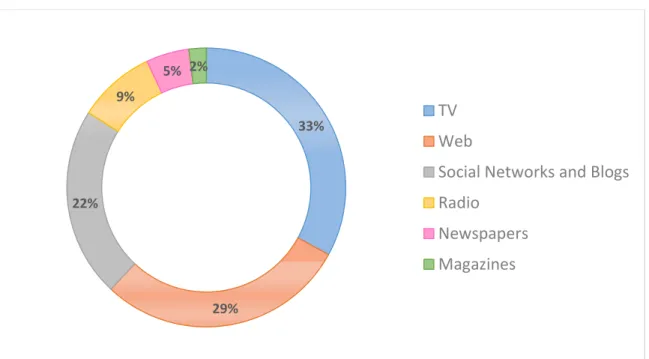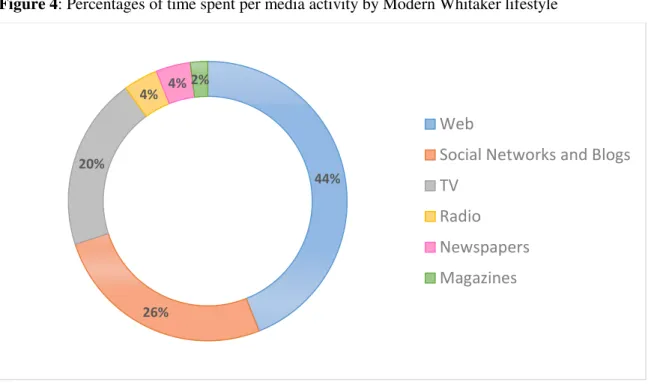3rd of June 2015
Andreia Maria da Silva Carrilho Duarte Lopes, student number: 1901
_________________________________________________________________________
A project carried out on the Customer Relationship Management course, under the supervision of: Elizabete Cardoso
2
FINDING NEW OPPORTUNITIES IN THE LISBON MARKET
THROUGH WHITAKER CONSUMER LIFESTYLE
SEGMENTATION
ABSTRACT
A sample of 445 consumers resident in distinct Lisbon areas was analyzed
through direct observations in order to discover each lifestyle’s current
proportion, applying the Whitaker Lifestyle™ Method. The findings of the
conducted hypothesis tests on the population proportion unveil that
Neo-Traditional and Modern Whitaker lifestyles have the significantly highest
proportion, while the overall presence of different lifestyles varies across
neighborhoods. The research further demonstrates the validity of Whitaker
observation techniques, media consumption differences among lifestyles
and the importance of style and aesthetics while segmenting consumers by
lifestyles. Finally, market opportunities are provided for firms operating in
Lisbon.
KEY WORDS
Whitaker Lifestyle™ Method
Lifestyle Segmentation
Style and aesthetics
3
General Overview
The objective of this project is the study of Lisbon consumers’ lifestyles, according
to Whitaker International. Each lifestyle´s current proportion was discovered through the
analysis of a sample of 445 Lisbon consumers whereby population proportions Hypothesis
tests were conducted to test the significance of the results. The understanding of each
lifestyle´s specific aesthetic preferences represents market opportunities for companies to
develop suitable products for each identified customer segment. Scott and Parfitt (2005), in
their study of the lifestyle impacts in the choices of travel and leisure activities defended that
the understanding of the customers’ lifestyles has marketing value as it enables the
understanding of how a product “fits a customer’s life”.
This project focuses on the study of lifestyle segmentation according to the Whitaker
Lifestyle™ Method developed by the Whitaker family in 1992 in New York City. This
method is an instrument that allows the analysis, segmentation and definition of customers
by style and aesthetics preferences and has been used in numerous international companies,
enabling them to foster profits due to better product positioning and marketing
communication.
The research entailed in this project, besides by studying Lisbon consumers through
lifestyle segmentation, examines the validity of the observation techniques developed by
Whitaker International, through a research that combines observation of customer with
in-depth interviews tailored to identify the lifestyle of interviewees through the identification of
4
consumption is examined and proposes certain communication strategies for the most
relevant Lisbon lifestyle segments.
Whitaker Lifestyle™ Method
The Whitaker Lifestyle™ Method was created to teach companies an easy and
practical way of understanding consumer needs. It all started in the nineties by its increasing
freedom entailing new professions, new technologies and mainly, new ways of thinking.
Each person has a very distinct personality differing from others, which, at that time, was not
perceived by most of the companies.
Fatima Whitaker felt an urge to intervene in order to minimize the market gap that
existed in the communication between consumers and companies. Her design background
allowed her to develop a specific sense of aesthetics which was a starting point to understand
that consumers where divided according to particular aesthetic preferences and how this
influenced their purchase decisions.
Segmentation allows a better understanding of customers and the development of
products to match the specific segments’ needs (Scott, 2005). According to Fatima,
“segmenting customers through age and income is useless compared to the insights that the
understanding of customers lifestyles can bring”. This reasoning came from the identification
of peoples’ aspirational lifestyles and the need to express it through clothing, accessories,
5
The premise of this method is the belief that lifestyle allows companies to better
understand and serve their customers, which was proved by positive business outcomes of
Fatima’s work with many international and Portuguese companies.
Literature Review
The philosopher and psychiatrist Alfred Adler (1870-1937) introduced the term “style
of life” in the early 1900’s to refer to the goals that people have and the methods they use to
reach them (Thyne et al., 2005; Todd and Lawson, 2001). Later in the 1960’s, Lazer (1964)
introduced the lifestyle concept in the Marketing field, which was based on the fact that
individuals have characteristic patterns of living, which may influence their motivation to
purchase products and brands (Miguéis et al., 2012).
The lifestyle segmentation approach divides consumers in different lifestyle types
(Zhu et al. 2009), whereby each type is characterized by a unique style of living, measured
by a wide range of Activities, Interests and Opinions (Wells and Tigert, 1971; Plummer,
1971).
Schoell and Guiltinan (1992) summarized the marketing field definition of lifestyle
as the consistent patterns that people follow in their lives, including how they spend their
time and money, and are identified through people’s Activities, Interests and Opinions.
Lifestyle provides a richer portrait of the consumer life compared to other
segmentation variables such as demographics and socioeconomics (Meidan, 1984; Vyncke,
6
give no indication as to why people from different segments consume specific products or
services (Craig-Lees et al., 1995; Lawson, Tidwell, Rainbird, Loudon and Della Bitta, 1999).
According to Frank et al. (1972), “lifestyle may be operationalized in two major
methods: by the examination of the products the person consumes or by the examination of
the person’s activities, interests, opinions, and values” (Scott and Parfitt, 2005).
Like most of the lifestyle segmentation research literature reviewed, the Whitaker
Lifestyle™ Method focuses on consumers’ activities, interests and opinions. In particular,
the Whitaker Lifestyle™ Method effectively uses both the products consumed and the AIO
method through the observation techniques centered on consumers’ clothing, shoes,
make-up, hairstyle, accessories, activities, interests and their relationships with friends and family.
As lifestyle arises from people’s values, it can offer insights on the purchase behavior
(Todd and Lawson, 2001). In fact, Thyne, in her study of museum visitors’ behavior, found
that visitors’ “values” determine why people visit museums and what they expect from the
experience (Thyne, 2001).
There is an abundance of literature on the link between consumer lifestyle and product
preferences (see Thack and Olsen 2004; Gonzalez and Bello 2002; Plummer 1971; Mathews
and Slocum 1970; Mathews and Slocum 1969). According to Craig-Lees et al., “in
marketing, the underlying premise is that consumers’ lifestyles will strongly influence their
consumption behavior” (Craig-Lees et al., 1995).
A study of the Chinese mobile phone market proved through a regression analysis
7
al., 2009). Additionally, it was concluded that the added value of a new product feature varies
with consumer lifestyle. From the abundant research done in the consumer behavior area, it
can be concluded that lifestyle measures give superior insights of customers, allowing more
effective communication and marketing strategies to be implemented. These findings can be
extremely important for companies as they may be able to save a lot of marketing and
research & development costs through the development of suitable attributes and products
for the according customer lifestyle.
Methodology
This project follows the participation in the module of “Creative Customer
Management – The Whitaker Lifestyle™Method” undertaken at Nova SBE and taught by
Fatima Whitaker, the creator of the Method. Within the module, the main discussed topics
are the Importance of Style and Design Preferences of Consumers in Lifestyle Marketing,
the 14 relevant Lifestyle Segments to the Global Consumer, the Lifestyle Retail Concept
Development, The Evolution of Style, and the Creativity and Importance of Senses. From
the 14 existing Lifestyle Segments, only 9 were considered in this research as they were the
first to be developed by Whitaker International and the ones with more detailed information,
including an extensive written description of the day-to-day life for both a typical female and
male person for each lifestyle segment. These descriptions, developed by the company along
the years, are based on a very close study of consumers and contain detailed information
about their Activities, Interests, Opinions and Values. An aspect greatly highlighted by
Whitaker International is the enormous weight which style and design preferences of
8
lifestyles have very distinct style and design preferences, which make it crucial for companies
to identify their customers’ style and design preferences in order to create a competitive edge
and sustain in the market.
Upon the decision of proceeding with this project, an expert interview with Fatima
Whitaker (which followed the interview guide in Appendix 1) was conducted in order to
validate the data contained in the observation table and the in-depth interviews (Appendix 2
and 3). Upon insights taken from this interview, adjustments were done to both research
instruments.
The followed methodology for the customer research was a two-stage process based
on observation and in-depth interviews as most researches done on lifestyle segmentation
used extensive questionnaires and in-depth interviews as Thyne et al. (2005) and Lawson et
al. (1999) as effective analysis tools.
The observation of customers was done through the use of an observation guide
(Appendix 2) containing the main observed information about each lifestyle group identified
in the analysis of the official Whitaker International documents. The observation of
customers entailed, besides the observable appearance reflected in their clothing style and
others, the observation and analysis of their actions. As the research objective concerns
customers’ actions reflected in their interests and activities, a way to discover it is to watch
customers taking their actions (Saunders et al., 2009). This process included the systematic
observation, recording, description, analysis and interpretation of people’s behavior
9
The observation research was done as a “participant observation”, which is a
qualitative method in which the researcher gets involved in the research setting, Avenidas
Novas, Baixa-Chiado and Príncipe Real, attempting to study people’s symbolic world
(Saunders et al., 2009). The role undertaken was of a “complete observer”, which implies
that the identity of the researcher and the purpose of the research were not revealed to the
observed people and the researcher did not take part in the activities (Saunders et al., 2009).
The observation of customers, done in two day-time periods, included three different
locations of Lisbon, chosen to represent the diversity of the population, as described in this
figure:
Figure 1: Representative map of the observation of customers
1
1 Source: http://europa.gratis.es/europa/portugal/lisboa/lisboa-mapa-de-lisboa-i1.jpg
Avenidas Novas
Príncipe Real
147
155
143
445
observed customers
10
For the qualitative research, informal and unstructured conversations, in-depth
interviews, were done with a total of 8 people. In-depth interviews are often referred to as
“qualitative research interviews” (King, 2004) because the structure of the interview may
change between interviewees. Some questions may be omitted while others are added and
the order of questions may also differ (Saunders et al., 2009). One of the goals of in-depth
interviews is to give the opportunity for the interviewees to explain and build on their
responses so that the researcher is able to probe answers (Saunders et al., 2009). In the case
of this research, in-depth interviews were useful to confirm the information gathered from
the observation. In this case, the researcher could make such questions to the interviewee that
would enable the confirmation of certain conclusions drawn before, while observing them.
This enabled the collection of a richer and detailed set of data (Saunders et. al, 2009).
The interviews were conducted face-to-face in an informal manner with people
passing by in the studied locations and took between ten and fifteen minutes on average. The
interview themes can be retrieved in Appendix 3.
Data quality issues
A few data quality issues can be associated to the use of in-depth interviews. The lack
of standardization may lead to concerns about reliability – whether other researchers would
reveal the same information or not. Additionally, there can be problems of reliability related
to biases, either an interviewer bias or a response bias. The interviewer comments, tone of
voice and non-verbal behavior create a bias in the interviewees’ responses. The interviewer
11
originated due to the unwillingness from the interviewee to reveal and discuss an aspect of
the topic that entails sensitive information they do not want to discuss (Saunders et al., 2009).
Regarding the participant observer study, the greatest threat to the reliability of the
research conclusions is the observer bias. The interpretation of people’s activities, interests,
opinions and values is influenced by the common sense and life experiences of the researcher.
However, it is possible to control the threat that reliability poses. (Saunders et al., 2009)
Results
The distribution of the Whitaker Lifestyle segments in Lisbon consumers according
to the researched sample is as per this graphic:
Figure 2: Distribution of Whitaker lifestyles in Lisbon according to the studied sample
It can be deduced that the Neo-Traditional and the Modern lifestyles are the most
relevant, accounting for more than 50% of the studied sample.
Neo-Traditional 36%
Modern 25% Traditional
13% Trendy
11% Artist
7% Eco-thinker
3%
Design 2%
Glamour 2%
12
As the following table represents, with a significance level of 95% and a p-value
equal to 5%, it can be said that the proportion of Lisbon population belonging to the
Neo-Traditional lifestyle is higher than the average population proportion (Po = 11%). The same
can be derived for the population belonging to the modern lifestyle. However, these are the
only lifestyles which population proportion was proved to be superior to Po = 11%, according
to the statistic hypothesis testing results.
Table 1: Hypothesis testing results of the population proportion of Whitaker Lifestyles in Lisbon
𝑋 𝑁 𝑝0 𝑝̂ 𝑝-value Result
Neo-Traditional
Lifestyle
161 445 0.11 0.36 0
Reject the Null Hypothesis:
𝑝 ≤ 0.11
Accept the Alternative Hypothesis:
𝑝 > 0.11
Modern
Lifestyle 112 445 0.11 0.25 0
Reject the Null Hypothesis:
𝑝 ≤ 0.11
Accept the Alternative Hypothesis:
𝑝 > 0.11
Traditional
Lifestyle 58 445 0.11 0.13 0.0983
Do Not Reject the Null Hypothesis:
𝑝 ≤ 0.11
Trendy
Lifestyle 48 445 0.11 0.11 0.1548
Do Not Reject the Null Hypothesis:
13
The distribution of lifestyles obtain from the studied sample presents different
proportions across the studied areas of Lisbon as the following table describes:
Table 2: Distribution of Whitaker lifestyles across Lisbon areas from studied sample
%
Neo-Trad Modern
Traditi
onal Trendy Artist
Eco-thinker Design
Glamo
ur Techno Avenidas
Novas 44.2% 15.0% 12.9% 10.2% 6.1% 2.7% 4.1% 4.1% 0.7% Principe
Real 39.9% 46.2% 11.2% 15.4% 7.0% 2.8% 1.4% 2.1% 0.0%
Baixa-Chiado 25.2% 15.5% 14.8% 7.1% 7.7% 1.9% 1.9% 1.3% 0.6%
To test the significance of the previous results, hypothesis tests about the population
proportion were implemented. The proportion of the modern lifestyle population is
significantly higher in Principe real than in the other areas of Lisbon, while the proportion of
the Neo-Traditional lifestyle population is significantly lower in Principe Real than in other
areas of Lisbon. The hypothesis tests results concerning differences of population proportion
of Whitaker Lifestyles between Príncipe Real and other Lisbon areas are described in the
following table:
Table 3: Hypothesis testing results of Whitaker Lifestyles’ population proportion in Principe Real
𝑋 𝑁 𝑝0 𝑝̂ 𝑝-value Result
Modern Lifestyle in
Principe Real
58 112 1
3 0.52 1.7𝐸−5
Reject the Null Hypothesis:
𝑝 ≤13
Accept the Alternative Hypothesis:
14 Trendy
Lifestyle in Principe
Real
20 48 1
3 0.42 0.1103
Do Not Reject the Null Hypothesis:
𝑝 ≤13
Neo-Traditional Lifestyle in Principe
Real
34 161 1
3 0.21 5.04𝐸−4
Reject the Null Hypothesis:
𝑝 ≤13
Accept the Alternative Hypothesis:
𝑝 >13
Artist Lifestyle in
Principe Real
13 31 1
3 0.42 0.1548
Do Not Reject the Null Hypothesis:
𝑝 ≤13
The proportion of the traditional lifestyle is significantly higher in Baixa-Chiado than
in the other areas of Lisbon, as described in the following table which summarizes the results
of the differences of Whitaker Traditional lifestyle population proportion in Baixa-Chiado
compared to the other Lisbon areas:
Table 4: Hypothesis tests results of Whitaker lifestyles’ population proportion in Baixa-Chiado
𝑋 𝑁 𝑝0 𝑝̂ 𝑝-value Result
Traditional Lifestyle in
Baixa-Chiado
32 58 1
3 0.55 0.0002
Reject the Null Hypothesis:
𝑝 ≤13
Accept the Alternative Hypothesis:
𝑝 >13
The proportion of Neo-Traditional lifestyle is significantly higher in Avenidas Novas
15
Table 5: Hypothesis test result of Whitaker Neo-Traditional lifestyle population proportion in Avenidas Novas
𝑋 𝑁 𝑝0 𝑝̂ 𝑝-value Result
Neo-Traditional Lifestyle in Avenidas
Novas
65 161 1
3 0.40 0.0290
Reject the Null Hypothesis:
𝑝 ≤13
Accept the Alternative Hypothesis:
𝑝 >13
There was an expectation for a variation of lifestyles’ distribution across
neighborhoods, which was the reason for the research to be proceeded in different places so
that the overall Lisbon results would include the variety of the Lisbon consumers. Modern
lifestyle entails a huge variation across different areas in the studied sample, from a 15%
presence until a 41% one. As proved through Hypothesis test of the population proportion,
Modern consumers are mostly present in the area of Principe Real where they live, work or
spend their free time. This result may be linked to the fact that the majority of homes,
activities, stores, restaurants and bars situated in this area have the right design and aesthetic
preferences desirable by this segment.
This research was able to prove that consumers of different lifestyles in Lisbon have
different style and aesthetic preferences. This was proved in two ways. First, the observation
of customers’ clothing, shoes, accessories, hairstyle and make-up was accurate for the
attribution of their lifestyles, which proves that people dress themselves according to certain
16
asked about their dream home, consumers chose accordingly to the expected design
preferences, see Appendix 4 for the used home images.
Validity of the observation techniques by the probing questions of the In-depth interviews
The probing questions developed in the in-depth interviews about the people’s
Activities, Interests, Opinions and Values were able to prove that the observation techniques
were correct, as 89% of interviewed consumers, which were initially considered of a certain
lifestyle, were concluded to still belong to the same lifestyle after the analysis of the
interview.
Results of Media consumption
The media consumption was studied for the two significant greater lifestyles:
Neo-Traditional and Modern. The studied sample entailed differences in the consumption of
Media across lifestyles as displayed in the following figures 3 and 4:
Figure 3: Percentages of time spent per media activity by Neo-traditional Whitaker lifestyle
33%
29% 22%
9%
5% 2%
TV
Web
Social Networks and Blogs
Radio
Newspapers
17
Figure 4: Percentages of time spent per media activity by Modern Whitaker lifestyle
With these results, companies can decide which media channels are most worth to
invest in for the communication of products tailored for a certain lifestyle target. Both
lifestyles have similar results on the total time spent watching media: 8 hours and 20 minutes
for the Neo-Traditional lifestyle and 9 hours for the Modern lifestyle. For companies
targeting the Neo-Traditional population, TV constitutes a good media channel, closely
followed by the Web. However, if a company is targeting Modern population, it should
mainly advertise its products through Websites in general combined with advertisement on
Social Networks and Blogs. Regarding the entire sample of customers, magazines,
newspapers and radio are the least consumed media, as, on average, less than 13% of all-time
spent watching media is spent with these media channels. Watching TV and navigating on
social networks, blogs and general websites represent, on average, more than 87% of the total
time spent with media.
44%
26% 20%
4%
4% 2%
Web
Social Networks and Blogs
TV
Radio
Newspapers
18
Unexpectedly, the circumstances and daytime of the consumption of the same media
is very similar across all different lifestyles. For instance, Social Networks during daytime,
are mostly assessed on smartphones by 88% of all interviewees. Accordingly, Television and
Web are used at home and after 9pm approximately by 75% and 63%, respectively.
Conclusion
In the Literature Review, the superiority that lifestyle segmentations in comparison
to demographic segmentations attain, was discussed; mainly on matters of understanding
customers purchase behavior, including product preferences and products’ features value
added. Lifestyles are the unique set of living followed by people, which identification has
been done by the majority of marketing researchers through customers’ Activities, Interests,
Opinions (AIO method) and Values.
The used methodology followed the common practices present on literature: the study
of Lisbon consumers’ lifestyles was done through the observation of their AIO and Values,
followed by in-depth interviews used to confirm the validity of the first method.
The results have shown that Whitaker Neo-Traditional and Modern population
lifestyles present a significantly higher proportion than other lifestyles in Lisbon, with a
p-value equal to 0 with a 95% level of confidence. Additionally, significant differences of some
Whitaker lifestyles’ population proportions crosswise Lisbon areas were found. Companies
may use these results to better position their points of sale according to the target segment.
From the in-depth interviews the differences in the visual aesthetic preferences of each
lifestyle were pointed out by their choices of dream homes’ images, in which unique colors,
19
4). In addition, the small sample of customers interviewed was able to demonstrate the
differences regarding media consumption patterns.
Besides the limitations of this research related to data quality issues arising from a
lack of reliability from both research methods, literature defends that the researcher is able
to control the threat that reliability poses by the knowledge of its existence (Saunders et al.
2009).
The opportunities for companies selling to customers residing in Lisbon, derived from
the results, are summarized in the following bullet points:
The use of lifestyle segmentation has numerous advantages in comparison to
demographic segmentation. Mainly, lifestyle segmentation gives insights on the
consumer purchase behavior (Todd and Lawson, 2001) and consumption behavior
(Craig-Lees et al., 1995).
Consumer lifestyle is linked to product preferences, where consumers from different
lifestyles have different product preferences and value the addition of product features in
a different manner (Zhu et al., 2009). This provides companies the opportunity to
decrease research & development costs by the development of the proper product
portfolio and attributes for the target segment.
Companies should target Neo-Traditional and Modern Whitaker Lifestyles has its
population proportion has a significantly higher presence in the Lisbon market than the
other Whitaker lifestyles.
In order to target the Neo-Traditional Whitaker segment, companies’ stores should be
20
through a combination of the following media channels by descendent level of
importance: television, general websites, social networks and blogs.
Modern Whitaker segment is correctly targeted with the placement of stores in Príncipe
Real and the communication of products done mainly through general websites, social
networks and blogs.
References
Craig-Lees, M.; Joy, S., and Browne, B. 1995. Consumer Behaviour. Singapore: John Wiley and Sons.
Frank, R. E.; Massy, W. F. and Wind, Y. J. 1972. Market Segmentation. Englewood Cliffs: Prentice Hall.
Gonzalez, Ana M. and Laurentino Bello. 2002. “The construct “lifestyle” in market
segmentation: The behaviour of tourist consumers.” European Journal of Marketing, 36(1): 51-85.
King, N. 2004. “Using interviews in qualitative research.” In Essential Guide to Qualitative
Methods in Organizational Research, C. Cassell and G. Symon, 11-22. London: Sage.
Lawson, R., Thyne,M., Young, T., and Juric, B. 1999. “Developing Travel Lifestyles: A New
Zealand Example.” Consumer Behaviour in Travel and Tourism, XX(Y): 449-511.
Lawson, R.;Tidwell, P.; Rainbird, P.; Loudon, D. and Della Bitta, A. 1999. Consumer Behaviour in Australia and New Zealand. Sydney: McGraw-Hill Inc.
Lazer, William. 1964. “Lifestyle Concepts and Marketing.” In Toward Scientific Marketing,
Greyser, Stephen A., Chicago: American Marketing Association.
Mathews, Lee H. and Slocum Jr., John W. 1969. “Social Class and Commercial Bank Credit
21
Mathews, Lee H. and Slocum Jr., John W. 1970. “Social Class and Income as Indicators of Consumer Credit Behavior.” Marketing Notes and Communications, ? (?): 69-74.
Meidan, A. 1984. Bank Marketing Management. New York: Macmillan.
Miguéis, V. L.; Camanho, A. S. e Falcão e Cunha, J. 2012. “Customer data mining for
lifestyle segmentation.” Expert Systems with Applications, 39: 9359-9366
Plummer, Joseph T. 1971. “Life Style Patterns and Commercial Bank Credit Card Usage.”
Journal of Marketing, 35(2): 35-41.
Saunders, Mark; Lewis, Philip and Thornhill, Adrian. 2009. Research Methods for Business Students. Edinburgh: Pearson Education Limited.
Schoell, W. F. and Guiltinan, J.P . 1992. Marketing: Contemporary Concepts and Practices. Boston: Allyn and Bacon.
Scott, Noel and Parfitt, Nick. 2005. “Lifestyle Segmentation in Tourism and Leisure.”
Journal of Quality Assurance in Hospitality & Tourism, 5(2-4): 121-139
Thack, Elizabeth C. and Olsen, Janeen E. 2004. “The Search for New Wine Consumers:
Marketing Focus on Consumer LifeStyle or LifeCycle.” International Journal of Wine
Marketing, 16(3): 44-57.
Thyne, Maree. 2001. “The Importance of Values Research for Nonprofit Organisations: The
Motivation-based Values of Museum Visitors.” The International Journal of Nonprofit and Voluntary Sector Marketing, 6 (2): 116-130.
Thyne, Maree; Davies, Sylvie and Nash, Rob. 2005. “A Lifestyle Segmentation Analysis of the Backpacker Market in Scotland.” Journal of Quality Assurance in Hospitality & Tourism, 5: 95-119.
22
Vyncke, Patrick. 2002. “Lifestyle Segmentation: From Attitudes, Interests and Opinions, to
Values, Aesthetic Styles, Life Visions and Media Preferences.” European Journal of
Communication, 17(4): 445-463.
Wells, W. D. and Tigert, D. J. 1971. “Activities, Interests and Opinions.” Journal of
Advertising Research, 11(4): 28-35.
Zhu, Hengyuan; Wang, Qing; Yan, Ligang and Wu, Guisheng. 2009. “Are consumers what
they consume? – Linking lifestyle segmentation to product attributes: an exploratory study of the Chinese mobile phone market.” Journal of Marketing Maanagment, 25: 295-314.
Appendices
Appendix 1: Interview Guide for Expert Interviewwith Fatima Whitaker
Description of the intended project and discussion about the Whitaker official information to be included.
May you describe the origins of the Whitaker Lifestyle Method?
How is the Whitaker Lifestyle Method applied in national and international companies
and what are the results obtained by the companies?
How do you believe that the Whitaker Lifestyle Method could help Lisbon companies?
Which industries in particular, of the Lisbon market, do you think that need a better
understanding of consumers?
What benefits the application of the Whitaker Lifestyle Method can bring for consumers?
Could you please evaluate the quality of the observation table, to be used in the future
research, and provide feedback.
It would also be important that you analyzed the quality of the home pictures, to be
Fin d in g n e w o p p o rtu n itie s in t h e L is b o n m ar k et th ro u g h W h itak er co n su m er lif e st y le se g m en tatio n 23 App en d ix 2 : Gu id in g t ab le f or ob se rvation Artist Modern Eco - thinker Trendy Design Neo - traditional Glamour Techno Traditional
Comfortable and very fun fabrics
Black and white basic pieces. Colorful pieces. Pieces with Volume and Shape.
Own made clothing with natural dyes or Comfortable clothing with natural fabrics. Follows the latest trends. Cool designer clothing Designers imitations at affordable prices
Pieces suitable for any occasion. Simple and clean pieces with volume and shape.
Practical but professional look.. Low-maintenance look.
Latest hottest designers looks. Fascination with beauty. Loud clothing from sexy designers.
Active wear. High tech, high performance fabrics. Women: Skirts with opaque tights and Blazer. Business: basic suit, white or blue monogrammed shirts, tie. Casual: navy blue blazer, white shirt, khaki trousers. Club: blazer with golden buttons.
Bright Black, white and bright colors Neutral colors and colors of nature. Trendy Same color head to toe. Greys, black and white. white, green and berries
Simple and practical Never Trendy Natural Simple but polished Polished None
Simple and practical Trendy Practical Simple but polished Polished None
Comfortable with fun colors and design Comfortable and very stylish. Trendy Heels to work Glam designers Sneakers hill pump Men: Leather lace-ups
Large Trendy None
24
Appendix 3: Themes for the In-Depth Interviews
Interview Themes
Demographics Sex
Birth range First Name Occupation Level of studies
Media consumption Time spent with each media channel (TV, Social Networks and Blogs, Radio, Magazines, Newpapers and Websites)
Specification of consumption (specific brands; circumstances and hours of consumption) Advertisement effectiveness (The recall of advertisement)
Lifestyle Values
Interests Activities
25
Appendix 4 – Images used to ask interviewees’ dream home on In-depth interviews.
Trendy
Artist
Modern
Eco-friendly
Glamour
Neo-Traditional
Design
Traditional
